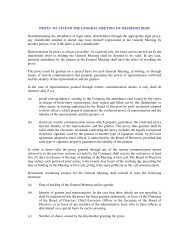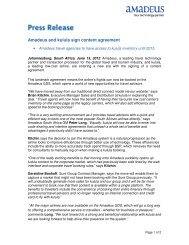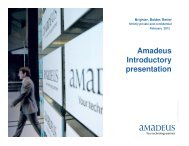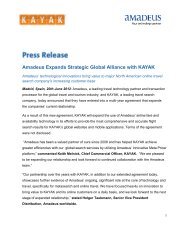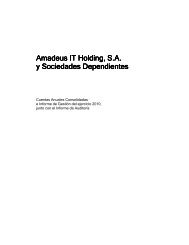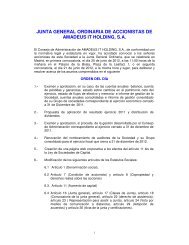Amadeus IT Holding, S.A. and Subsidiaries - Investor relations at ...
Amadeus IT Holding, S.A. and Subsidiaries - Investor relations at ...
Amadeus IT Holding, S.A. and Subsidiaries - Investor relations at ...
You also want an ePaper? Increase the reach of your titles
YUMPU automatically turns print PDFs into web optimized ePapers that Google loves.
AMADEUS <strong>IT</strong> HOLDING, S.A. AND SUBSIDIARIES<br />
NOTES TO THE CONSOLIDATED ANNUAL ACCOUNTS FOR THE YEARS ENDED<br />
DECEMBER 31, 2011, AND 2010<br />
(EXPRESSED IN THOUSANDS OF EUROS - KEUR)<br />
21. DERIVATIVE FINANCIAL INSTRUMENTS<br />
In the normal course of business the Group enters into deriv<strong>at</strong>ive financial<br />
instruments to manage the financial risks exposures which it is subject to. An outline<br />
of the Group’s financial risks, the objectives <strong>and</strong> policies pursued in rel<strong>at</strong>ion to those<br />
risks are described in note 5.<br />
IAS 39 prescribes strict criteria for hedge accounting. Although all the deriv<strong>at</strong>ives we<br />
enter into are contracted for hedging purposes in economic terms, there might be<br />
instances when a deriv<strong>at</strong>ive is not an effective hedge from an accounting<br />
perspective. In these situ<strong>at</strong>ions, the deriv<strong>at</strong>ive is classified as held for trading, <strong>and</strong><br />
the gains <strong>and</strong> losses from changes in the fair value are accounted in profit <strong>and</strong> loss,<br />
<strong>and</strong> presented in the st<strong>at</strong>ement of comprehensive income within “Financial expense,<br />
net”. If the deriv<strong>at</strong>ive financial instrument is design<strong>at</strong>ed as a cash flow hedge for<br />
accounting purposes, the changes in the fair value of the instrument are accounted<br />
through other comprehensive income presented within “Cash flow hedges”, <strong>and</strong><br />
through profit or loss when the hedged flow takes place.<br />
At the inception of a hedge <strong>rel<strong>at</strong>ions</strong>hip, the Group formally documents the hedge<br />
<strong>rel<strong>at</strong>ions</strong>hip to which the Group wishes to apply hedge accounting. Such hedges are<br />
expected to be highly effective in achieving offsetting changes in the fair value <strong>and</strong><br />
cash flows, <strong>and</strong> are assessed on an ongoing basis to determine th<strong>at</strong> they actually<br />
have been highly effective throughout the reporting period for which they were<br />
design<strong>at</strong>ed.<br />
The ideal hypothetical deriv<strong>at</strong>ive method is used to measure ineffectiveness of a<br />
hedge <strong>rel<strong>at</strong>ions</strong>hips in which the hedging instrument is a deriv<strong>at</strong>ive. The ideal<br />
hypothetical deriv<strong>at</strong>ive method compares the change in fair value of the actual<br />
deriv<strong>at</strong>ive design<strong>at</strong>ed as the hedging instrument <strong>and</strong> the change in fair value of an<br />
"ideal hypothetical deriv<strong>at</strong>ive" th<strong>at</strong> would result in perfect hedge effectiveness for the<br />
design<strong>at</strong>ed hedged item.<br />
In the case of the foreign exchange n<strong>at</strong>ural hedge, as it is explained in the<br />
document<strong>at</strong>ion of the hedge <strong>rel<strong>at</strong>ions</strong>hip, the dual spot method is used. This means<br />
th<strong>at</strong> the Group compares the spot-to-spot movement of the hedged item with the<br />
spot-to-spot movement of the hedging instrument in order to calcul<strong>at</strong>e hedge<br />
effectiveness.<br />
89





